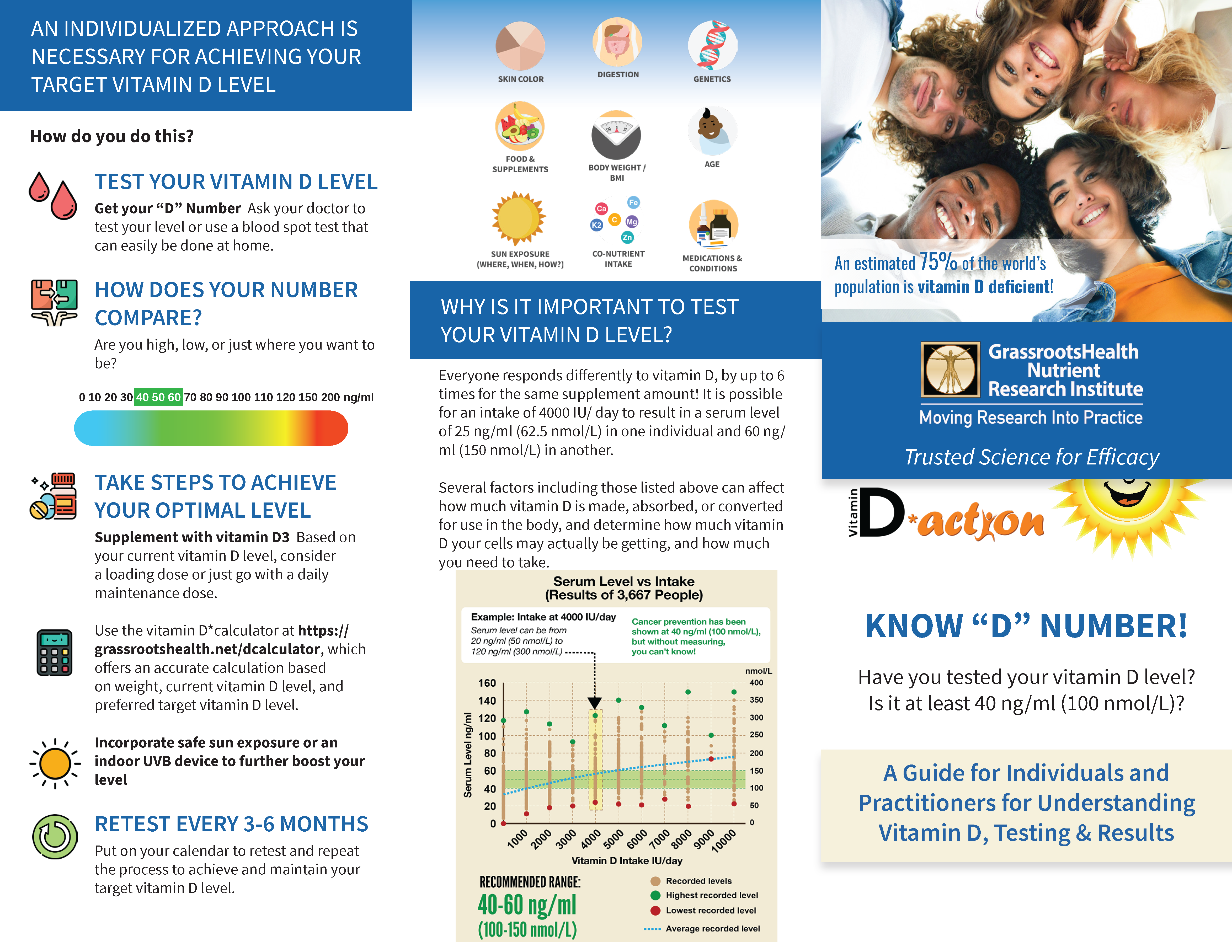Use this free download as a tool to help educate those around you about vitamin D and the importance of knowing your level! Download, print and share today
The new Know “D” Number brochure is a condensed guide to understanding vitamin D, testing, and results. It covers frequently asked questions about vitamin D (see below), as well as steps for taking an individualized approach to reaching and maintaining your desired target vitamin D level.


What’s in the Brochure?
The inside of the brochure includes the following FAQs.
What is vitamin D?
Vitamin D, which is both a nutrient and a hormone, is needed by virtually every cell in the body and is essential for hundreds of processes each and every day. It acts as a regulator of all cell types, tissues, and organs, and enhances the functioning of each system of the body to help keep us healthy.
Why do we need vitamin D?
Every tissue in our bodies needs vitamin D and may be impaired if we do not get enough. In its most extreme forms, vitamin D deficiency results in rickets in children and osteomalacia (bone softening) in adults. The GrassrootsHealth panel of 48 Vitamin D scientists recommends a vitamin D blood level (measured as 25(OH)D) in the range of 40-60 ng/ml (100-150 nmol/L) for disease prevention.
How do you get Vitamin D?
People obtain vitamin D from three sources: sun exposure, food sources, and supplements. In the past, humans achieved the optimal vitamin D blood level of 40-60 ng/ml (100-150 nmol/L) living a nomadic lifestyle. However, most modern humans are not able to reach optimal blood levels with the occasional sun exposure and food sources typical of modern day living without supplementation.
Can Vitamin D deficiency also indicate a “Sunshine Deficiency”?
YES! Your vitamin D level is one way to tell if you are getting enough sunshine, especially if not taking vitamin D supplements. Sunshine has many benefits beyond vitamin D, and helps the body produce other important chemicals and nutrients, such as nitric oxide and melatonin. Sunshine exposure also results in the production of serotonin and beta- endorphins, which promote mood enhancement and relaxation, relieve pain, and boost immunity. Proper sun exposure is a must, with the most important rule being “don’t burn!”
How can you know if you are vitamin D deficient?
The only way to know is to measure your vitamin D level. The total 25(OH)D level is the accepted measure used to determine your current vitamin D status. Measuring vitamin D is essential to know if an individual is getting enough and how much additional vitamin D may be needed!
People who have current vitamin D deficiency may not have any symptoms or may experience any of the following symptoms: lack of focus, dizziness, frequent infections, exhaustion, weakness, headaches, body pain, depression, and anxiety.
Vitamin D deficiency has been linked to
BRAIN: Depression & Anxiety, Schizophrenia, Alzheimer’s Disease, ADHD & Autism
CIRCULATORY: High Blood Pressure, Peripheral Artery Disease, Coronary Heart Disease, Atrial Fibrillation
RESPIRATORY: Colds & Flu, Pneumonia & Acute Respiratory Distress Syndrome (ARDS), Asthma, Tuberculosis
MUSCLE: Neuromuscular Pain, Weakness, Injury
BONE: Rickets, Osteoporosis, Fracture
AUTO-IMMUNE: Diabetes, Crohn’s Disease, Cancer, Multiple Sclerosis, Psoriasis
REPRODUCTIVE: Infertility, Preterm Birth
What other nutrients are important?
A major influence on how the body is able to respond to a specific nutrient is the status of its co-nutrients. Co-nutrients that are especially important to vitamin D include omega-3 fatty acids, magnesium, vitamin K2, calcium, boron, zinc, and B vitamins. It is essential to ensure an adequate supply of these nutrients through diet and/or supplementation.
Why is it important to test your vitamin D level?
Everyone responds differently to vitamin D, by up to 6 times for the same supplement amount! It is possible for an intake of 4000 IU/ day to result in a serum level of 25 ng/ml (62.5 nmol/L) in one individual and 60 ng/ ml (150 nmol/L) in another.
Several factors including those listed above can affect how much vitamin D is made, absorbed, or converted for use in the body, and determine how much vitamin D your cells may actually be getting, and how much you need to take.
Also illustrated in the brochure are personalized steps to take on how to reach and maintain a desired target vitamin D level! Download the brochure to learn more.
